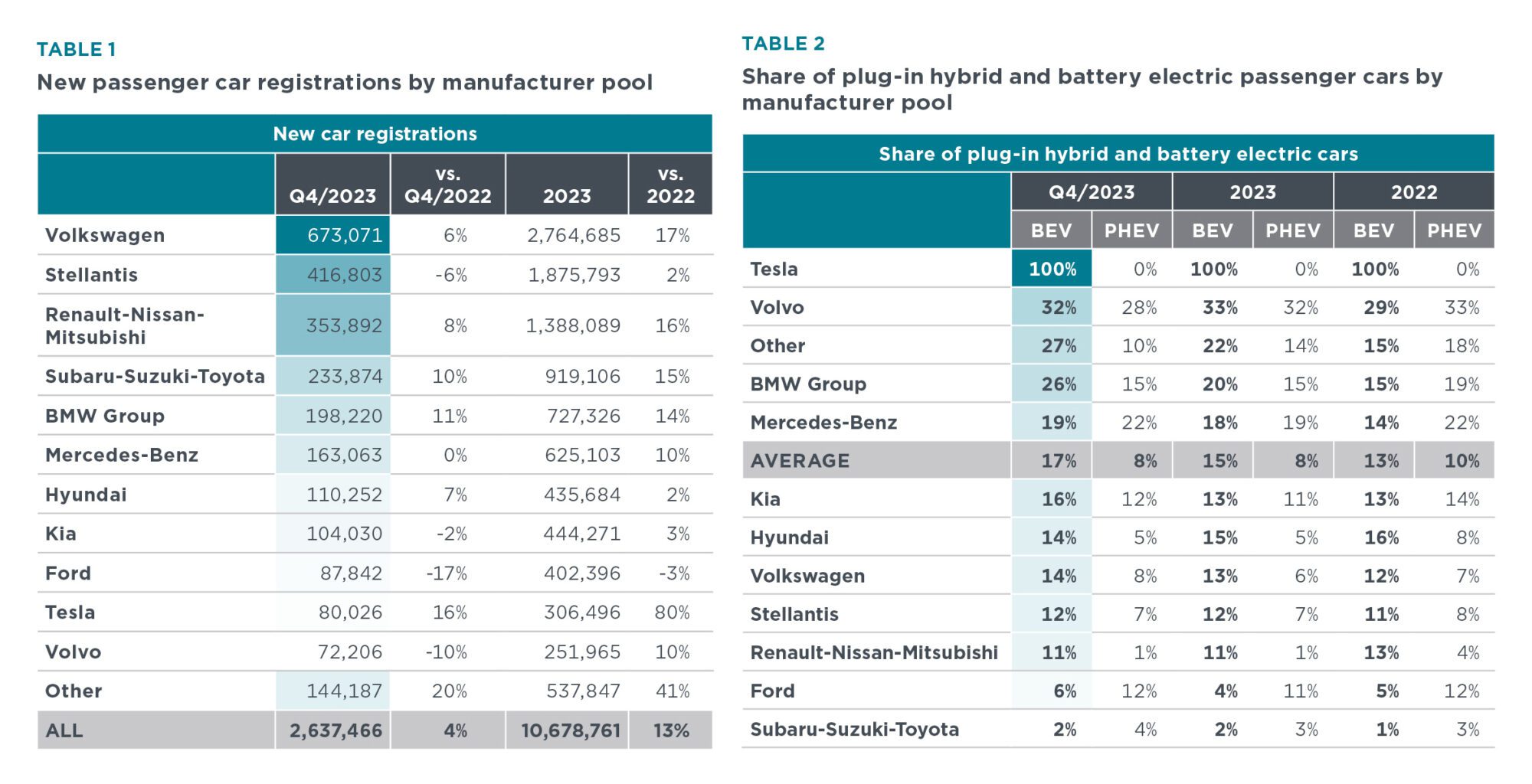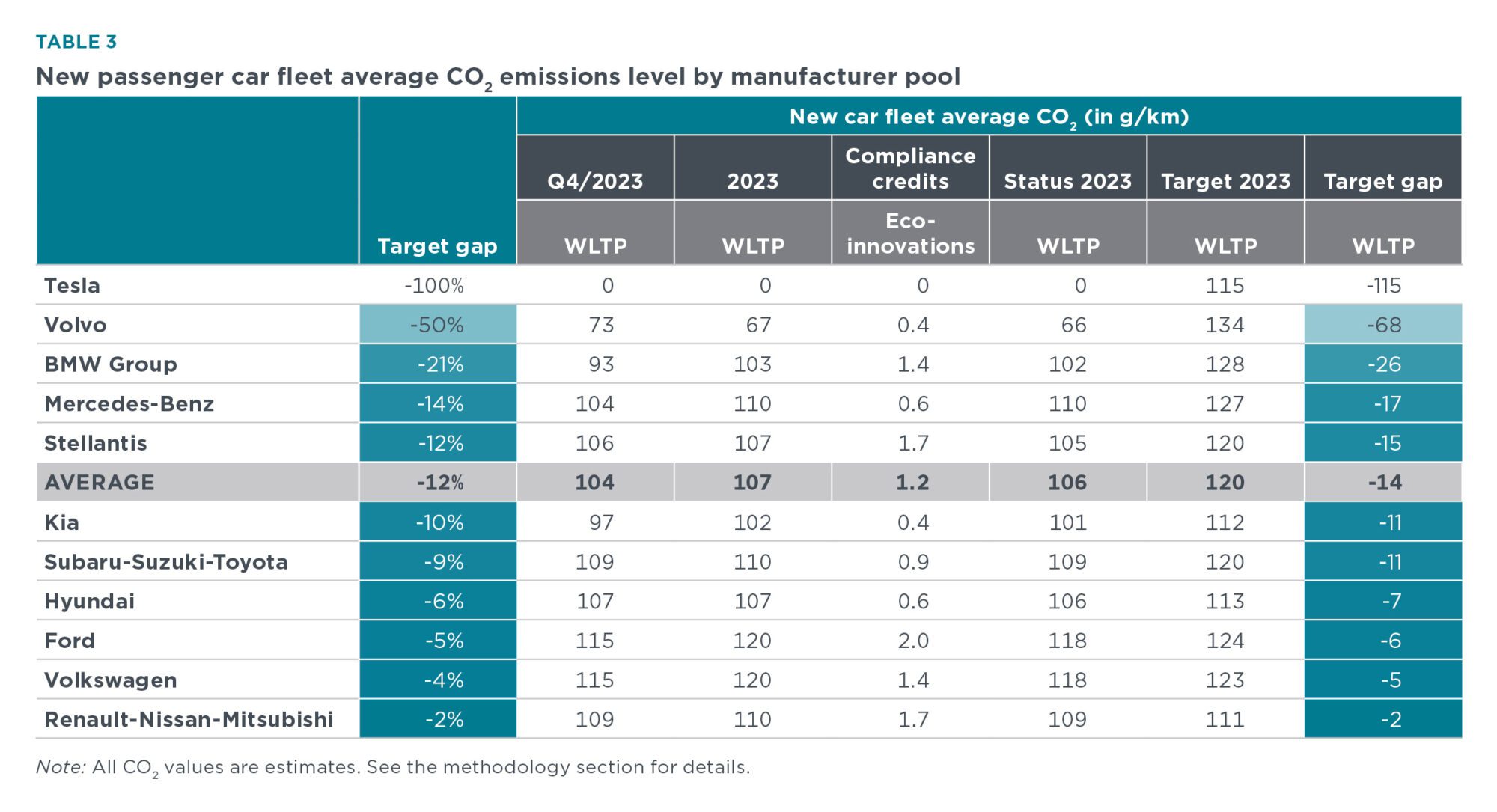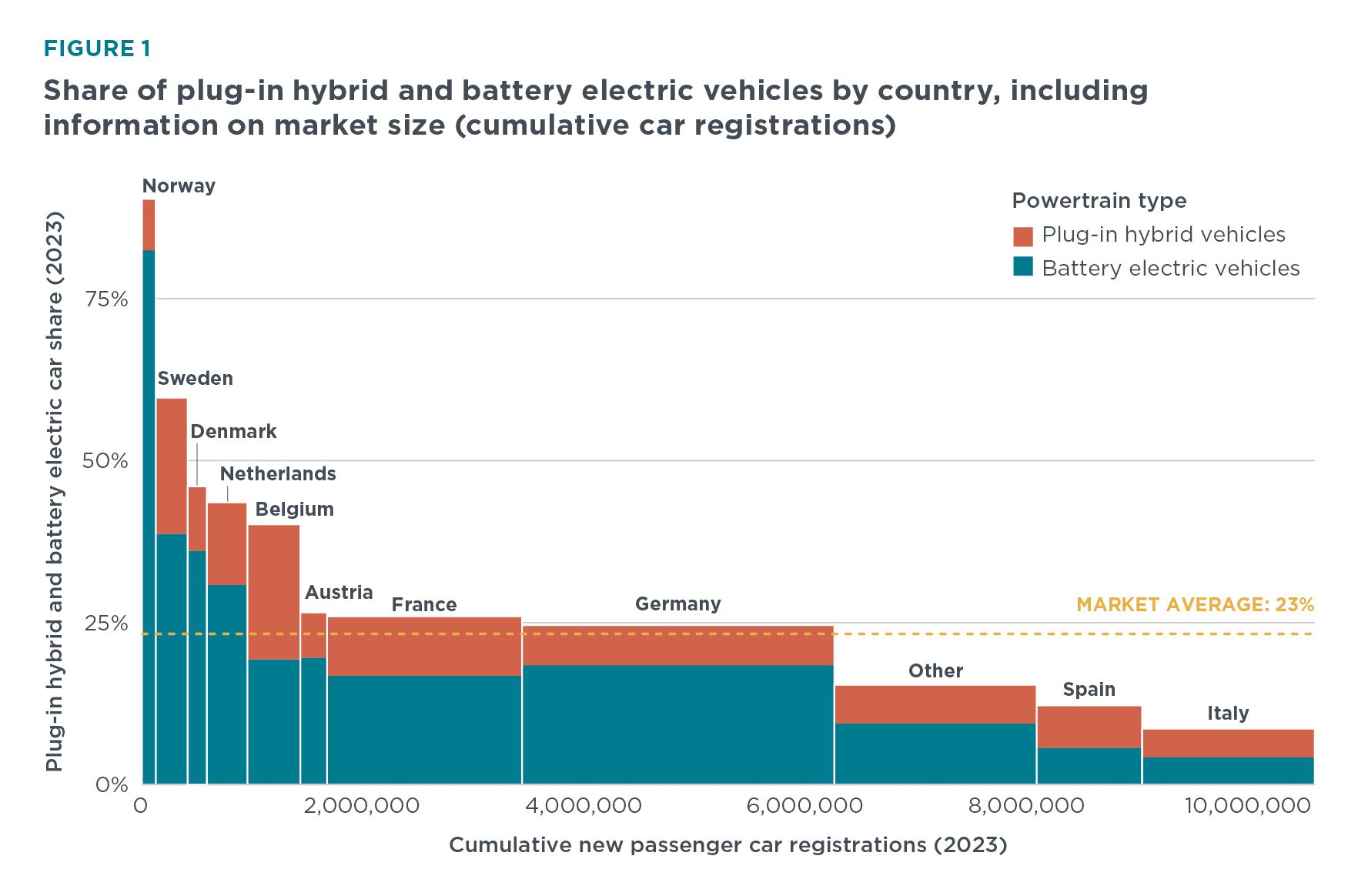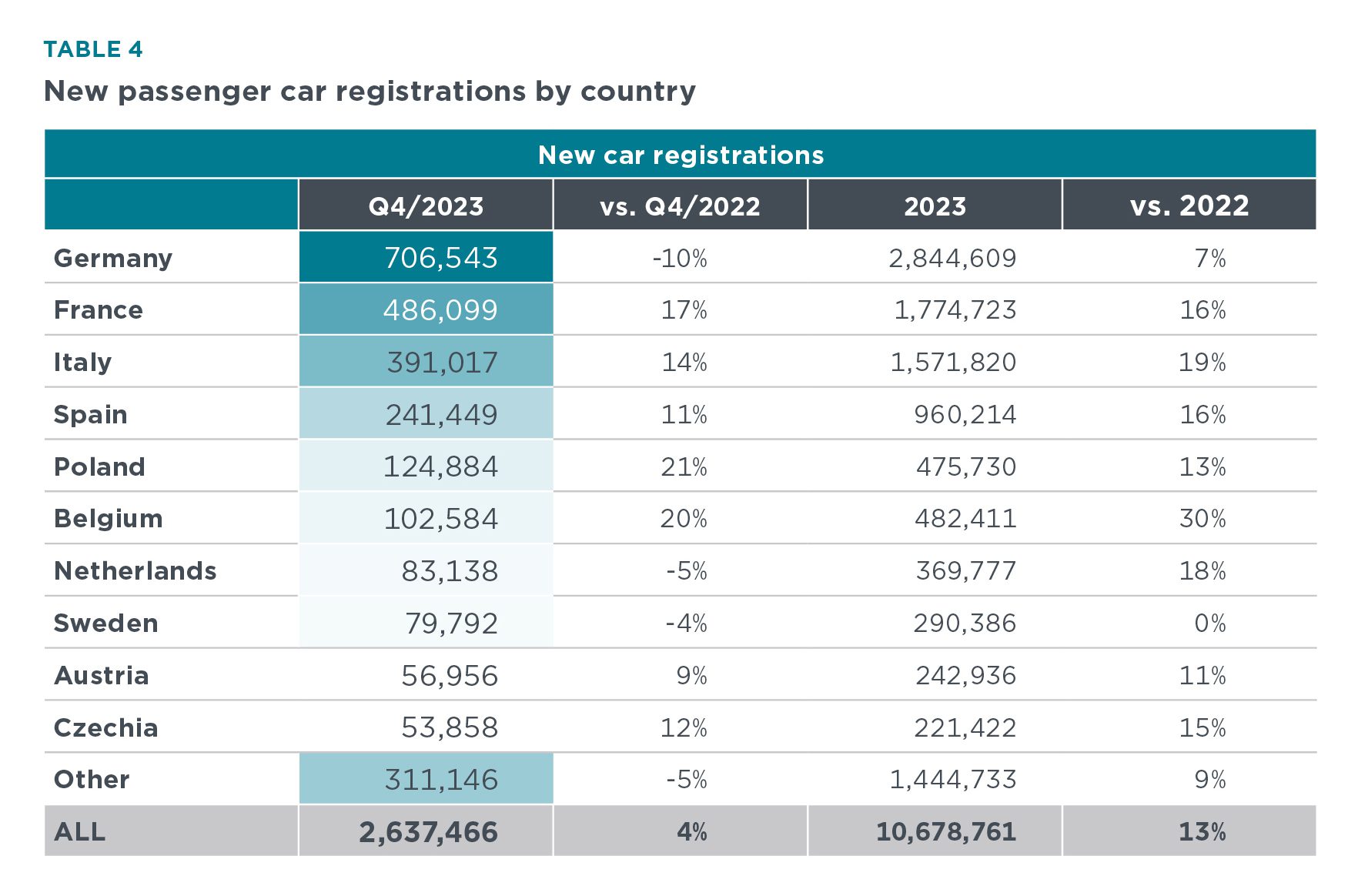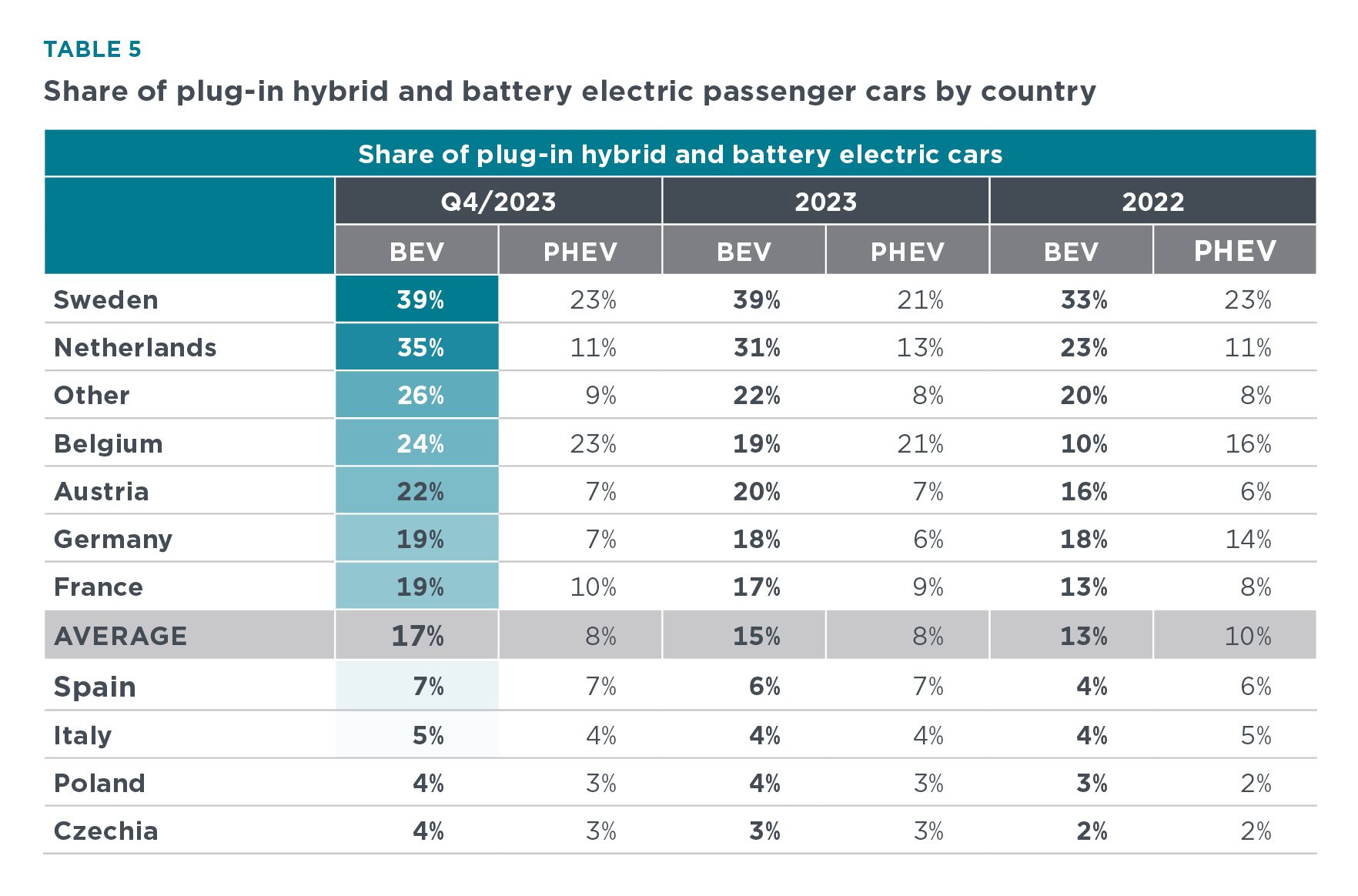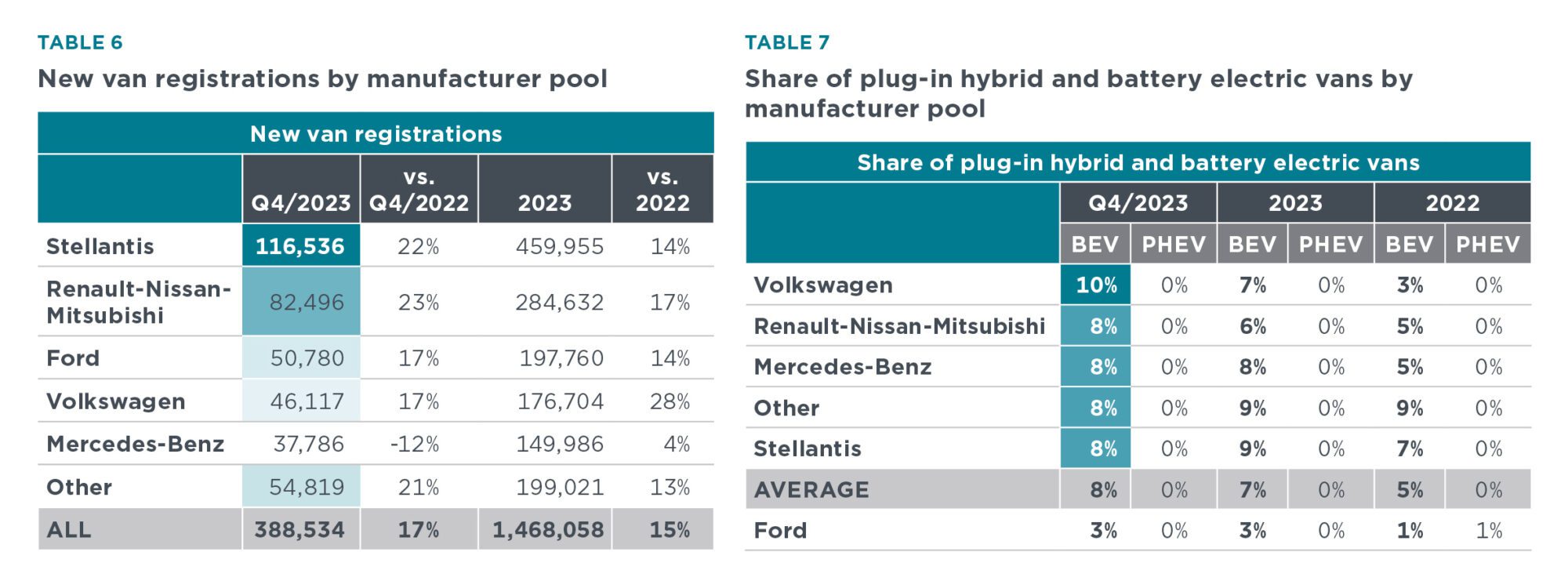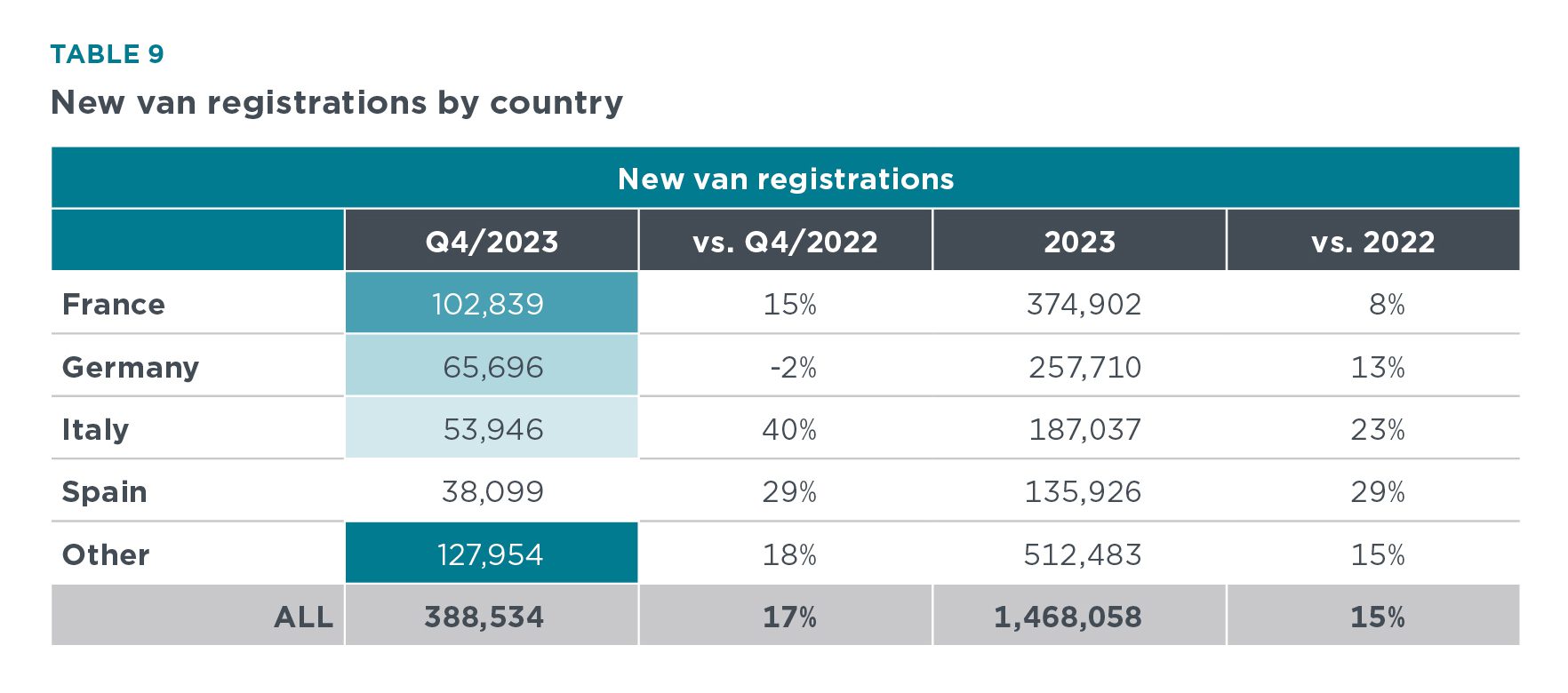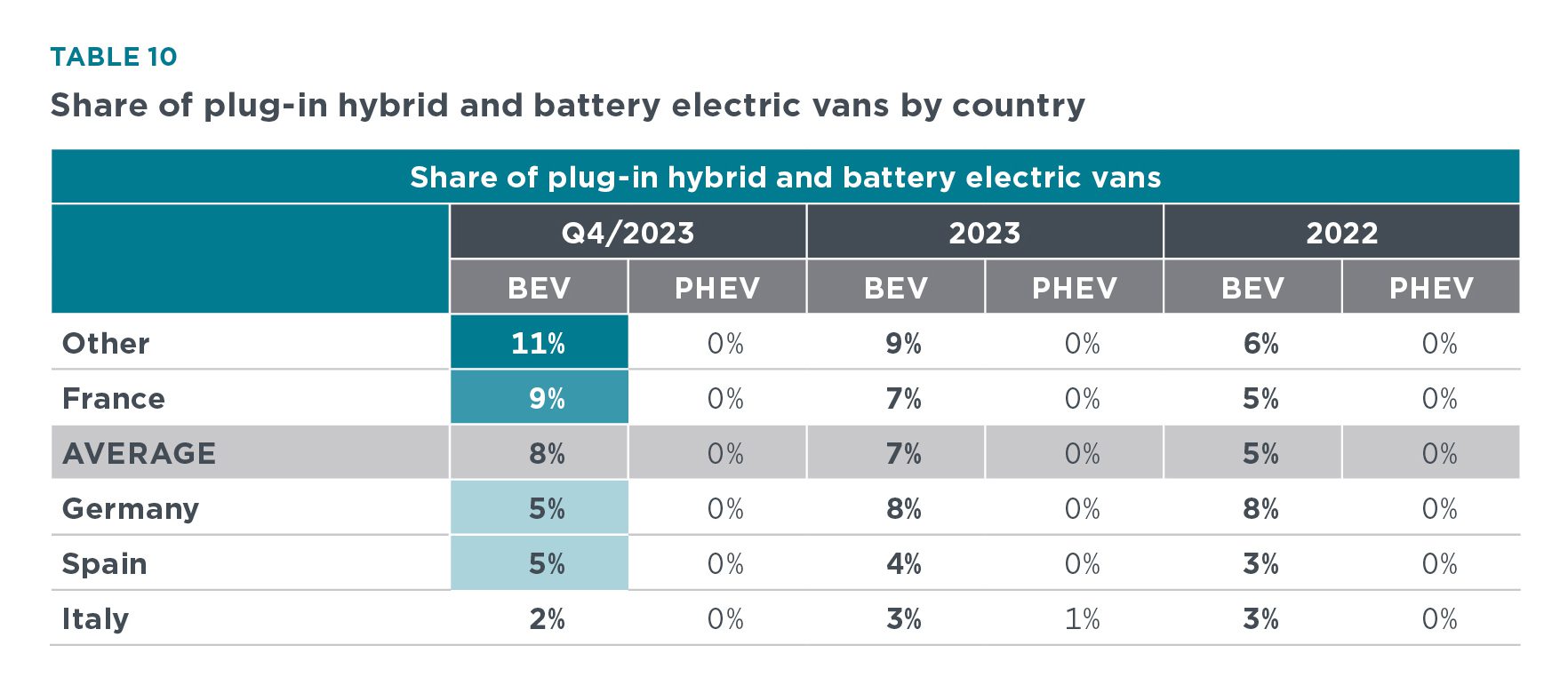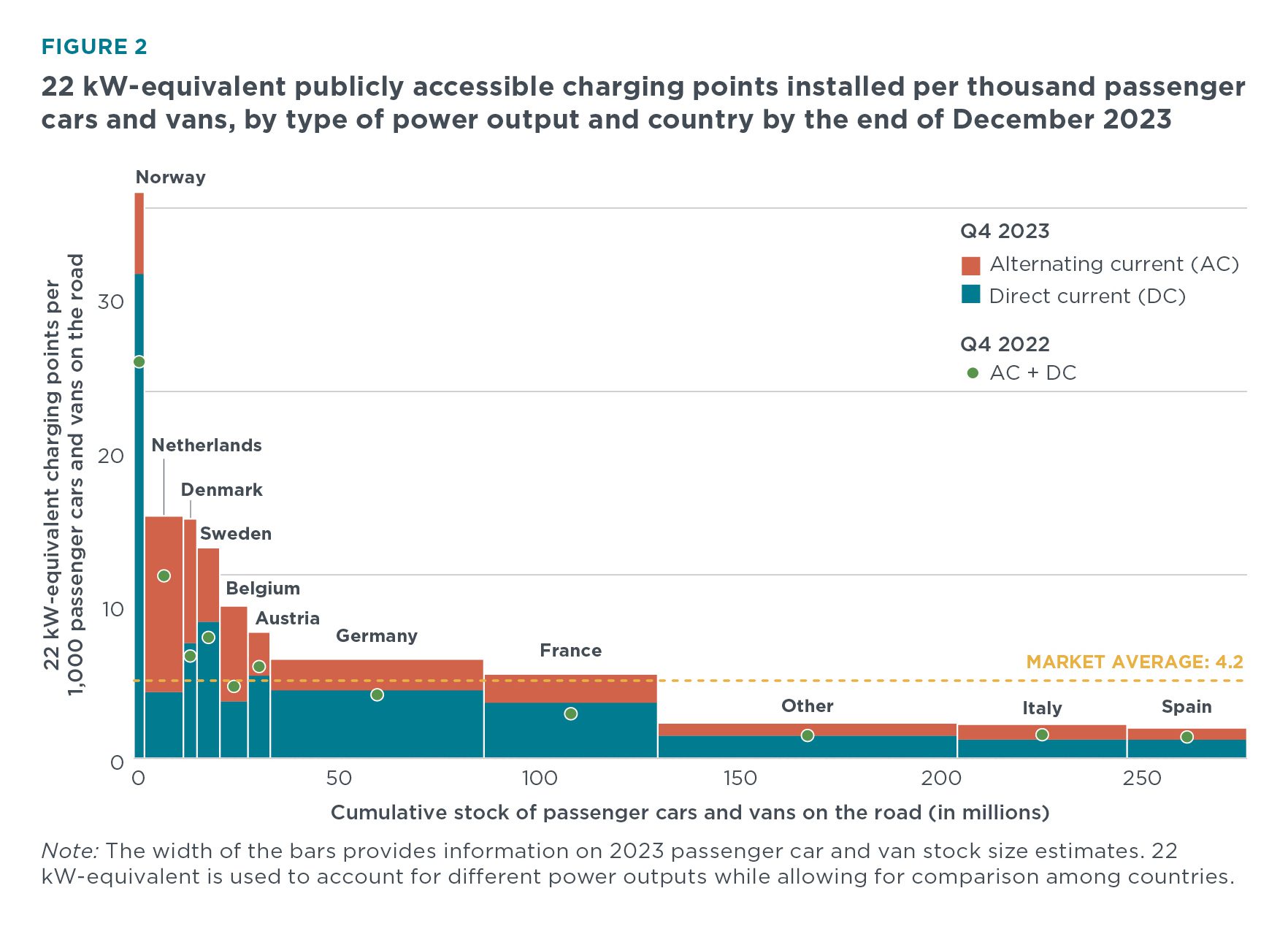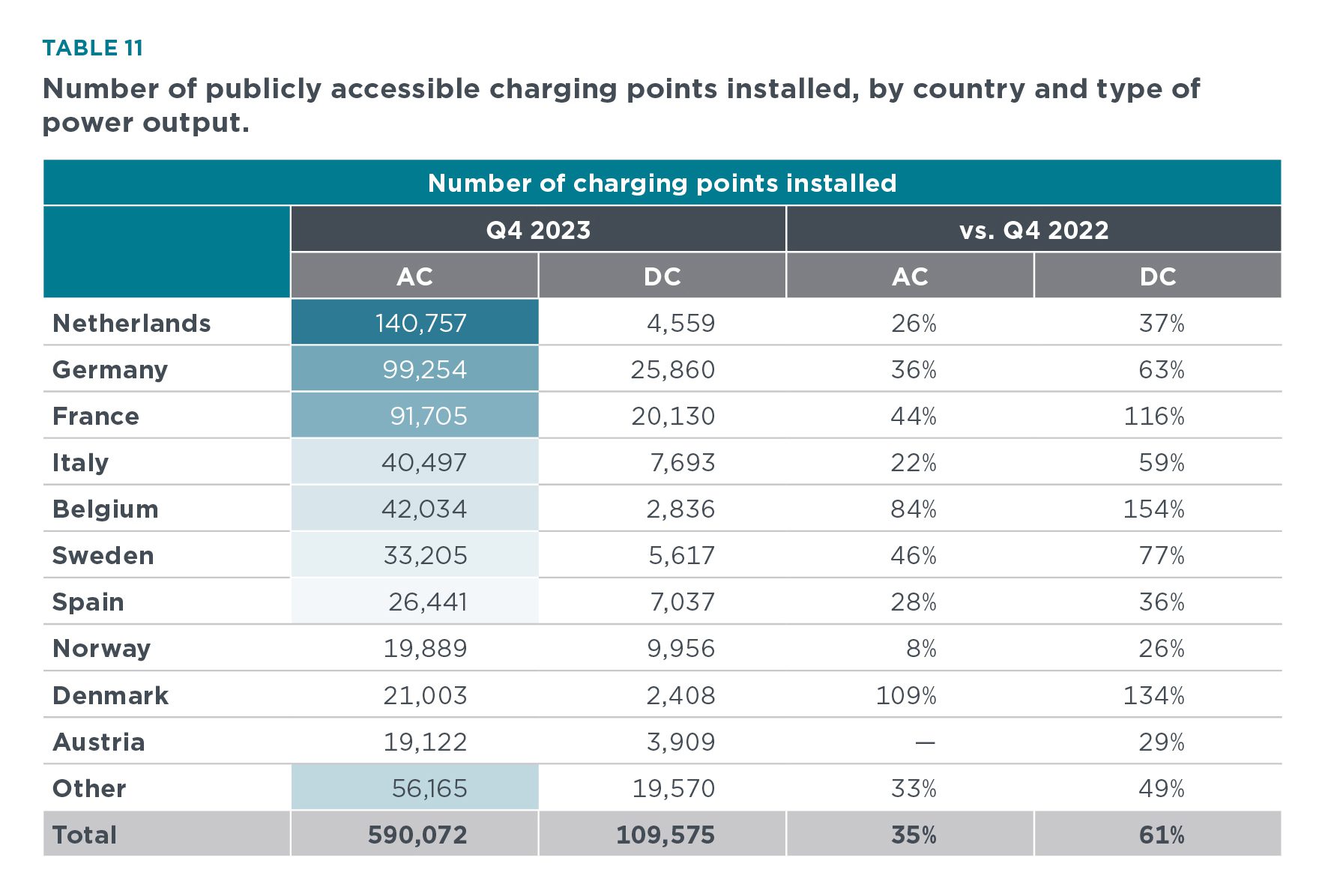Market Spotlight
European Market Monitor Quarterly
European car and van market and charging infrastructure development: January–December 2023
Passenger car registrations
New car registrations in Europe increased an average of 13% in 2023, with a 4% increase in the fourth quarter compared with the same period the previous year. Tesla stood out with an 80% increase in registrations in 2023, followed by Volkswagen (+17%). Registrations of Ford (-3%) and Stellantis (+2%) largely stagnated in 2023. The average European market share of battery electric vehicles (BEVs) in 2023 was about 15%, with a 17% market share in the fourth quarter, four percentage points higher than the 2022 average. Both Ford (6%) and the Subaru-Suzuki-Toyota pool (2%) continued to lag in shares of BEV registrations.1 The average plug-in hybrid electric vehicle (PHEV) share remained below 2022 levels in 2023 by about two percentage points. All manufacturers were able to meet their specific CO2 emissions targets for 2023, with an estimated average over-compliance of about 14 g CO2/km.
🔍 Click on the figures to take a closer look at the data
Passenger car registrations by country
BEV and PHEV market shares averaged 23% in Europe in 2023. Norway (90%), Iceland (61%), Sweden (60%), and Finland (55%) all had shares above 50%, while Denmark (46%), the Netherlands (44%), and Belgium (40%) also had well above average BEV and PHEV market shares for Europe. Among the largest markets, the largest increase in BEV registrations occurred in Belgium, where shares increased 9 percentage points in 2023 compared with 2022. In the Netherlands, new BEV sales reached an all-time high of 35% in the fourth quarter of 2023. Of the major markets, 2023 PHEV registration shares were the highest in Belgium and Sweden (both 21%).
🔍 Click on the figures to take a closer look at the data
Van registrations
Almost 1,470,000 new vans were registered in Europe in 2023, a 15% increase over 2022. Volkswagen (+28%) had the largest gains last year, while Mercedes-Benz van registrations only slightly increased (+4%). On average, battery electric vans represented 8% of new van registrations in 2023, up from 5% in 2022. While most manufacturers had above-average BEV market shares, Ford battery electric van shares averaged only 3% in 2023. The market share of battery electric vans stagnated at 8% in Germany in 2023, while the share in France increased to 7%, up from 5% in 2022. All manufacturers were able to meet their CO2 targets for 2023, with average overcompliance of 2 g CO2/km.
🔍 Click on the figures to take a closer look at the data
Charging infrastructure development
Nearly 700,000 public charging points were installed in Europe by the end of 2023, up from around 650,000 at the end of September. For alternating current (AC) charging, this represents an increase of around 35% compared with the end of 2022. Direct current (DC) charging points showed even greater growth, increasing 61% over the end of 2022. Approximately 84% of Europe’s public charging points supply AC, while the remaining 16% supply DC. In addition to considerable shares of BEV registrations, Denmark also recorded the largest growth in terms of AC chargers in 2023 compared with 2022 (+109%) and the second-largest growth in DC chargers (+134%). Only Belgium (+154%) recorded a greater increase in DC charging points in the same period. There were on average about 4.2 22 kW-equivalent publicly accessible charging points installed per thousand passenger cars and vans on the road at the end of December 2023, up from 3.8 at the end of September. With nearly 31 22 kW-equivalent publicly accessible charging points per thousand passenger cars and vans, Norway continues to lead Europe in charging infrastructure expansion, followed by Iceland (17), the Netherlands (13), Denmark (13), and Sweden (11). Italy (1.9) and Spain (1.7) remain well below the European average.
🔍 Click on the figures to take a closer look at the data
Definitions, data sources, methodology, and assumptions
- Manufacturer pools: Automakers are allowed to form pools to jointly comply with CO2 targets. For this publication, the definition of pools according to the European Commission’s “M1 pooling list,” version of 7 January 2024, applies (main brands listed here): BMW Group (BMW, Mini), Ford (Ford), Hyundai (Hyundai), Kia (Kia), Mercedes-Benz (Mercedes-Benz, Smart), Renault-Nissan-Mitsubishi (Dacia, Mitsubishi, Nissan, Renault), Stellantis (Alfa Romeo, Citroën, Fiat, Jeep, Lancia, Opel, Peugeot), Subaru-Suzuki-Toyota (Lexus, Subaru, Suzuki, Toyota), Tesla (Tesla), Volkswagen (Audi, Cupra, Porsche, SEAT, Škoda, VW), and Volvo (Volvo). For light commercial vehicles, the “N1 pooling list,” version of 7 January 2024, applies: Ford (Ford), Mercedes-Benz (Mercedes-Benz, Mitsubishi Fuso), Renault-Nissan-Mitsubishi (Mitsubishi, Nissan, Renault), Stellantis (Citroën, Fiat, Opel, Peugeot), Volkswagen (MAN, Volkswagen).
- Abbreviations: AC = alternating current; CO2 = carbon dioxide emissions; DC = direct current; g/km = grams per kilometer; N/A = not available; YTD = year to date.
- Technical scope: This publication focuses on new passenger car and light commercial vehicle registrations. Electric vehicles here include battery electric (BEV) and plug-in hybrid electric (PHEV).
- Geographic scope: The European CO2 regulation for vehicle manufacturers applies to all countries of the European Economic Area (EEA). This includes the 27 Member States of the European Union plus Iceland, Liechtenstein, and Norway. Data for new car and van registrations and shares of electric vehicles in this publication cover all of these countries, with the exception of Bulgaria, Liechtenstein, and Malta. Data for CO2 emission levels additionally omit Hungary, Lithuania (until January 2021), Poland (until April 2020), and Romania (together less than 10% of the total market). Charging infrastructure data are presented for the 27 EU members plus the four European Free Trade Association countries (Iceland, Liechtenstein, Norway, and Switzerland).
- Data sources: Dataforce (new vehicle registrations), Eco-Movement (charging points).
- Results may change over time: Registrations and/or CO2 data may be retrospectively updated by some of the national type-approval authorities. Similarly, charging infrastructure data may also be retrospectively updated by Eco-Movement. Historical values are regularly updated to reflect all latest data available.
- Test procedures: CO2 values are provided according to the Worldwide harmonized Light vehicles Test Procedure (WLTP).
- Flexible compliance mechanisms: To facilitate meeting their CO2 targets, manufacturers can make use of a number of compliance mechanisms. Manufacturers can reduce their CO2 level by up to 7 g/km by deploying eco-innovation technologies. To incentivize eco-innovations, CO2 savings from eco-innovations per passenger car and light commercial vehicle are amplified by multipliers in the years 2021, 2022, and 2023. For 2023, the multiplier is set to 1.5. As a conservative estimate, we apply the 2022 level of eco-innovation CO2 emission reductions per manufacturer. For more on the methodology used see: Uwe Tietge, Peter Mock, and Jan Dornoff, Overview and evaluation of eco-innovations in European passenger car CO2 standards, (ICCT: Washington, DC, 2018), https://theicct.org/publications/eco-innovations-european-passenger-car-co2-standards.
- Mass-based targets: For each manufacturer pool, a specific 2023 CO2 target value applies, depending on the average mass of the new vehicles registered. For this publication, we assume the average mass per manufacturer pool to remain constant with respect to the market situation in 2022. For more on the methodology used see: Jan Dornoff, Víctor Valverde, and Uwe Tietge, CO2 emissions from new passenger cars in Europe: Car manufacturers’ performance in 2022, (ICCT: Washington, DC, 2024), https://theicct.org/publication/co2-emissions-new-pv-europe-car-manufacturers-performance-2022-feb24/.
- Charging point: As defined in the Alternative Fuels Infrastructure Regulation, a charging point “means a fixed or mobile interface that allows for the transfer of electricity to an electric vehicle, which, whilst it may have one or several connectors to accommodate different connector types, is capable of recharging only one electric vehicle at a time, and excludes devices with a power output less than or equal to 3.7 kW the primary purpose of which is not recharging electric vehicles.”

